In recent months, Bitcoin has captured significant attention, driven by both market dynamics and external influences. As cryptocurrencies increasingly become a playground for speculation and investment, commentary from regulatory figures can dramatically affect market behavior. Recently, Federal Reserve Chair Jerome Powell made remarks relating Bitcoin to gold, which sparked both intrigue and optimism among crypto investors. This article delves into Powell’s comments, the implications for Bitcoin’s market status, and the broader context surrounding its volatility.
In a conversation with CNBC, Powell stated that while he does not personally own Bitcoin, it represents a speculative asset primarily competing with gold rather than traditional currencies like the U.S. dollar. This delineation is critical for several reasons. First, it elevates Bitcoin’s status from being merely a fringe asset to a serious contender in the broader financial ecosystem. By framing Bitcoin in relation to gold, Powell inadvertently grants it a degree of legitimacy, portraying it as a tangible alternative store of value, albeit a volatile one.
Powell’s assertion that Bitcoin is not a direct competitor to fiat currencies reinforces a vital argument made by many crypto proponents, emphasizing its role as a digital asset rather than a replacement for conventional monetary systems. This viewpoint suggests that Bitcoin’s intrinsic value may derive not from its use in transactions, but rather from its ability to act as a hedge against economic instability, much like gold.
Following Powell’s comments, Bitcoin experienced an immediate price increase, soaring over 4% to exceed the $103,000 threshold. Such an upward movement can be attributed to both Powell’s remarks and the growing interest in cryptocurrency from traditional investors. Market analysts highlight that Powell’s comparison to gold offers a “significant development,” enhancing Bitcoin’s credibility, especially given the ongoing volatility that characterizes this digital currency. Joel Kruger of LMAX Group noted that with Bitcoin’s current valuation still markedly lower than gold’s, there exists substantial growth potential for Bitcoin.
The correlation between regulatory discourse and market activity is profound; when influential figures weigh in on the legitimacy of an asset class, it often mitigates perceived uncertainties. For Bitcoin, the sensitivity to Powell’s remarks underscores its speculative nature, where confidence can rapidly shift based on external validation.
The backdrop against which Bitcoin’s price has spiked is also noteworthy. Following the victory of Donald Trump in the recent presidential election, Bitcoin’s rise reflects not merely speculative trends but also sentiment tied to the prospective economic policies anticipated under Trump. His administration’s perceived friendliness toward cryptocurrency has cultivated an environment where investors feel emboldened to rally behind Bitcoin as a potentially lucrative asset.
Meanwhile, gold has demonstrated relatively stable pricing in comparison, underlining a potential shift in investor focus. While gold climbed approximately 30% year-to-date, it has remained stagnant since the election results, indicating that the allure of cryptocurrencies—particularly Bitcoin—has captured the imaginations of many investors seeking explosive opportunities.
As the cryptocurrency landscape evolves, the role of regulatory frameworks remains pivotal. The possibility of appointing pro-crypto figures, such as financier Paul Atkins as SEC chair, could foster a more conducive environment for digital assets. Such developments may further enhance investor confidence and contribute to Bitcoin’s maturation as a mainstream asset class. However, the lingering shadow of regulatory uncertainty necessitates careful navigation by investors and traders alike.
The interrelation between fiscal commentary, market dynamics, and investor sentiment defines the current trajectory of Bitcoin. Powell’s statements not only shed light on the growing recognition of Bitcoin as an asset akin to gold but also illustrate the intricate connections within the broader financial ecosystem. As we look forward, the interplay between regulatory authorities and the cryptocurrency market will continue to shape investment strategies and outcomes.

